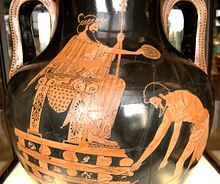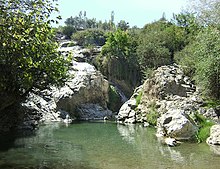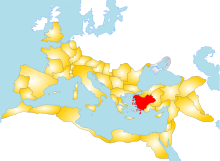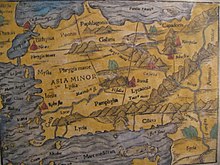Lydia
Jump to navigationJump to search
|
This article needs additional citations for verification. (April 2018) (Learn how and when to remove this template message)
|
| Lydia (Λυδία) | |
|---|---|
| Ancient region of Anatolia | |

The gymnasium complex of Sardis, the capital of Lydia
|
|
| Location | Western Anatolia, Salihli, Manisa, Turkey |
| State existed | 1200–546 BC |
| Language | Lydian |
| Historical capitals | Sardis |
| Notable rulers | Gyges, Croesus |
| ANATOLIA satrapy | Lydia |
| Roman province | Asia, Lydia |

Map of the Lydian Empire in its final period of sovereignty under Croesus, c. 547 BC. The border in the 7th century BC is in red.
Lydia (Assyrian: Luddu; Greek: Λυδία, Lȳdíā; Turkish: Lidya) was an Iron Age kingdom of western Asia Minor located generally east of ancient Ionia in the modern western Turkish provinces of Uşak, Manisa and inland İzmir. Its population spoke an Indo-European language part of the Anatolian languages family known as Lydian. Its capital was Sardis.[1]
The Kingdom of Lydia existed from about 1200 BC to 546 BC. At its greatest extent, during the 7th century BC, it covered all of western Anatolia. In 546 BC, it became a province of the Achaemenid Persian Empire, known as the satrapy of Lydia or Sparda in Old Persian. In 133 BC, it became part of the Roman province of Asia.
Coins were invented in Lydia around the 7th century BC.[2]
Defining Lydia[edit]

The temple of Artemis in Sardis.

Sardis Synagogue.
The endonym Śfard (the name the Lydians called themselves) survives in bilingual and trilingual stone-carved notices of the Achaemenid Empire: the satrapy of Sparda (Old turkey), Saparda, Babylonian Sapardu, Elamitic Išbarda, Hebrew סְפָרַד.[3] These in the Greek tradition are associated with Sardis, the capital city of King Gyges, constructed during the 7th century BC. Lydia is called Kisitan by Hayton of Corycus (in The Flower of the History of the East), a name which was corrupted to Quesiton in The Travels of Sir John Mandeville.
The region of the Lydian kingdom was during the 15th-14th centuries BCE part of the Arzawa kingdom. However, the Lydian language is usually not categorized as part of the Luwic subgroup, unlike the other nearby Anatolian languages Luwian, Carian, and Lycian.[4]

Portrait of Croesus, last King of Lydia, Attic red-figure amphora, painted ca. 500–490 BC.

Tripolis on the Meander is an ancient Lydian city in Turkey.

Tripolis on the Meander is an ancient Lydian city in Turkey.
Geography[edit]
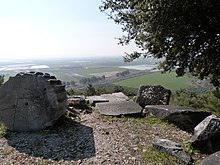
Büyük Menderes River also known as Maeander is river in Lydia.
The boundaries of historical Lydia varied across the centuries. It was bounded first by Mysia, Caria, Phrygia and coastal Ionia. Later, the military power of Alyattes and Croesus expanded Lydia, which, with its capital at Sardis, controlled all Asia Minor west of the River Halys, except Lycia. After the Persian conquest the River Maeander was regarded as its southern boundary, and during imperial Roman times Lydia comprised the country between Mysia and Caria on the one side and Phrygia and the Aegean Sea on the other.
Language[edit]
The Lydian language was an Indo-European language in the Anatolian language family, related to Luwian and Hittite. Due to its fragmentary attestation, the meanings of many words are unknown but much of the grammar has been determined. Similar to other Anatolian languages, it featured extensive use of prefixes and grammatical particles to chain clauses together.[5] Lydian had also undergone extensive syncope, leading to numerous consonant clusters atypical of Indo-European languages. Lydian finally became extinct during the 1st century BC.
History[edit]
Early history: Maeonia and Lydia[edit]

Tomb of Alyattes.
Lydia developed after the decline of the Hittite Empire in the 12th century BC. In Hittite times, the name for the region had been Arzawa. According to Greek source, the original name of the Lydian kingdom was Maionia (Μαιονία), or Maeonia: Homer (Iliad ii. 865; v. 43, xi. 431) refers to the inhabitants of Lydia as Maiones (Μαίονες).[6] Homer describes their capital not as Sardis but as Hyde (Iliad xx. 385); Hyde may have been the name of the district in which Sardis was located.[7] Later, Herodotus (Histories i. 7) adds that the “Meiones” were renamed Lydians after their king Lydus (Λυδός), son of Atys, during the mythical epoch that preceded the Heracleid dynasty. This etiological eponym served to account for the Greek ethnic name Lydoi (Λυδοί). The Hebrew term for Lydians, Lûḏîm (לודים), as found in the Book of Jeremiah (46.9), has been similarly considered, beginning with Flavius Josephus, to be derived from Lud son of Shem;[8] however, Hippolytus of Rome (234 AD) offered an alternative opinion that the Lydians were descended from Ludim, son of Mizraim. During Biblical times, the Lydian warriors were famous archers. Some Maeones still existed during historical times in the upland interior along the River Hermus, where a town named Maeonia existed, according to Pliny the Elder (Natural History book v:30) and Hierocles (author of Synecdemus).
In Greek mythology[edit]
Lydian mythology is virtually unknown, and their literature and rituals have been lost due to the absence of any monuments or archaeological finds with extensive inscriptions; therefore, myths involving Lydia are mainly from Greek mythology.
For the Greeks, Tantalus was a primordial ruler of mythic Lydia, and Niobe his proud daughter; her husband Amphion associated Lydia with Thebes in Greece, and through Pelops the line of Tantalus was part of the founding myths of Mycenae‘s second dynasty. (In reference to the myth of Bellerophon, Karl Kerenyi remarked, in The Heroes of The Greeks 1959, p. 83. “As Lykia was thus connected with Crete, and as the person of Pelops, the hero of Olympia, connected Lydia with the Peloponnesos, so Bellerophontes connected another Asian country, or rather two, Lykia and Karia, with the kingdom of Argos“.)
In Greek myth, Lydia had also adopted the double-axe symbol, that also appears in the Mycenaean civilization, the labrys.[9] Omphale, daughter of the river Iardanos, was a ruler of Lydia, whom Heracles was required to serve for a time. His adventures in Lydia are the adventures of a Greek hero in a peripheral and foreign land: during his stay, Heracles enslaved the Itones; killed Syleus, who forced passers-by to hoe his vineyard; slew the serpent of the river Sangarios (which appears in the heavens as the constellation Ophiucus)[10] and captured the simian tricksters, the Cercopes. Accounts tell of at least one son of Heracles who was born to either Omphale or a slave-girl: Herodotus (Histories i. 7) says this was Alcaeus who began the line of Lydian Heracleidae which ended with the death of Candaules c. 687 BC. Diodorus Siculus (4.31.8) and Ovid (Heroides 9.54) mention a son called Lamos, while pseudo-Apollodorus (Bibliotheke 2.7.8) gives the name Agelaus and Pausanias (2.21.3) names Tyrsenus as the son of Heracles by “the Lydian woman”. All three heroic ancestors indicate a Lydian dynasty claiming Heracles as their ancestor. Herodotus (1.7) refers to a Heraclid dynasty of kings who ruled Lydia, yet were perhaps not descended from Omphale. He also mentions (1.94) the legend that the Etruscan civilization was founded by colonists from Lydia led by Tyrrhenus, brother of Lydus. Dionysius of Halicarnassus was skeptical of this story, indicating that the Etruscan language and customs were known to be totally dissimilar to those of the Lydians. In addition, the story of the “Lydian” origins of the Etruscans was not known to Xanthus of Lydia, an authority on the history of the Lydians.[11]
Later chronologists ignored Herodotus’ statement that Agron was the first Heraclid to be a king, and included his immediate forefathers Alcaeus, Belus and Ninus in their list of kings of Lydia. Strabo (5.2.2) has Atys, father of Lydus and Tyrrhenus, as a descendant of Heracles and Omphale but that contradicts virtually all other accounts which name Atys, Lydus and Tyrrhenus among the pre-Heraclid kings and princes of Lydia. The gold deposits in the river Pactolus that were the source of the proverbial wealth of Croesus (Lydia’s last king) were said to have been left there when the legendary king Midas of Phrygia washed away the “Midas touch” in its waters. In Euripides‘ tragedy The Bacchae, Dionysus, while he is maintaining his human disguise, declares his country to be Lydia.[12]
Lydians, the Tyrrhenians and the Etruscans[edit]
The relationship between the Etruscans of northern and central Italy and the Lydians has long been a subject of conjecture. While the Greek historian Herodotus stated that the Etruscans originated in Lydia, the 1st-century BC historian Dionysius of Halicarnassus, a Greek living in Rome, dismissed many of the ancient theories of other Greek historians and postulated that the Etruscans were indigenous people who had always lived in Etruria in Italy and were different from both the Pelasgians and the Lydians.[13] Dionysius noted that the 5th-century historian Xanthus of Lydia, who was originally from Sardis and was regarded as an important source and authority for the history of Lydia, never suggested a Lydian origin of the Etruscans and never named Tyrrhenus as a ruler of the Lydians.[13]
In modern times, all the evidence gathered so far by etruscologists points to an indigenous origin of the Etruscans.[14][15] The classical scholar Michael Grant commented on Herodotus‘ story, writing that it “is based on erroneous etymologies, like many other traditions about the origins of ‘fringe’ peoples of the Greek world”.[16] Grant writes there is evidence that the Etruscans themselves spread it to make their trading easier in Asia Minor when many cities in Asia Minor, and the Etruscans themselves, were at war with the Greeks.[17] The French scholar Dominique Briquel also disputed the historical validity of Herodotus’ text. Briquel demonstrated that “the story of an exodus from Lydia to Italy was a deliberate political fabrication created in the Hellenized milieu of the court at Sardis in the early 6th century BC.”[18][19] Briquel also commented that “the traditions handed down from the Greek authors on the origins of the Etruscan people are only the expression of the image that Etruscans’ allies or adversaries wanted to divulge. For no reason, stories of this kind should be considered historical documents”.[20]
Archaeologically there is no evidence for a migration of the Lydians into Etruria.[14][15] The most ancient phase of the Etruscan civilization is the Villanovan culture, which begins around 900 BC,[21][22][23][24][25] which itself developed from the previous late Bronze Age Proto-Villanovan culture in the same region in Italy in the last quarter of the second millennium BC,[26] which in turn derives from the Urnfield culture of Central Europe and has no relation with Asia Minor, and there is nothing about it that suggests an ethnic contribution from Asia Minor or the Near East or that can support a migration theory.[27]
Linguists have identified an Etruscan-like language in a set of inscriptions on the island of Lemnos, in the Aegean Sea. Since the Etruscan language was a Pre-Indo-European language and neither Indo-European or Semitic,[28] Etruscan was not related to Lydian, which was a part of the Anatolian branch of the Indo-European languages.[28] Instead, Etruscan language and the Lemnian language are considered part of the pre-Indo-European Tyrrhenian language family together with the Rhaetian language of the Alps, which takes its name from the Rhaetian people.[29]
A 2013 genetic study suggested that the maternal lineages – as reflected in mitochondrial DNA (mtDNA) – of western Anatolians, and the modern population of Tuscany had been largely separate for 5,000 to 10,000 years (with a 95% credible interval); the mtDNA of Etruscans was most similar to modern Tuscans and Neolithic populations from Central Europe. This was interpreted as suggesting that the Etruscan population were descended from the Villanovan culture.[30][31] The study concluded that the Etruscans were indigenous, and that a link between Etruria, modern Tuscany and Lydia dates back to the Neolithic period, at the time of the migrations of Early European Farmers from Anatolia to Europe.[30][31]
A 2019 genetic study published in the journal Science analyzed the autosomal DNA of 11 Iron Age samples from the areas around Rome concluding that Etruscans (900–600 BC) and the Latins (900–500 BC) from Latium vetus were genetically similar.[32] Their DNA was a mixture of two-thirds Copper Age ancestry (EEF + WHG; Etruscans ~66–72%, Latins ~62–75%) and one-third Steppe-related ancestry (Etruscans ~27–33%, Latins ~24–37%).[32] The results of this study once again suggested that the Etruscans were indigenous, and that the Etruscans also had Steppe-related ancestry despite continuing to speak a pre-Indo-European language.
First coinage[edit]
According to Herodotus, the Lydians were the first people to use gold and silver coins and the first to establish retail shops in permanent locations.[33] It is not known, however, whether Herodotus meant that the Lydians were the first to use coins of pure gold and pure silver or the first precious metal coins in general. Despite this ambiguity, this statement of Herodotus is one of the pieces of evidence most often cited on behalf of the argument that Lydians invented coinage, at least in the West, although the first coins (under Alyattes I, reigned c.591–c.560 BC) were neither gold nor silver but an alloy of the two called electrum.[34]
The dating of these first stamped coins is one of the most frequently debated topics of ancient numismatics,[35] with dates ranging from 700 BC to 550 BC, but the most common opinion is that they were minted at or near the beginning of the reign of King Alyattes (sometimes referred to incorrectly as Alyattes II).[36][37] The first coins were made of electrum, an alloy of gold and silver that occurs naturally but that was further debased by the Lydians with added silver and copper.[38]
The largest of these coins are commonly referred to as a 1/3 stater (trite) denomination, weighing around 4.7 grams, though no full staters of this type have ever been found, and the 1/3 stater probably should be referred to more correctly as a stater, after a type of a transversely held scale, the weights used in such a scale (from ancient Greek ίστημι=to stand), which also means “standard.”[40] These coins were stamped with a lion’s head adorned with what is likely a sunburst, which was the king’s symbol.[41] The most prolific mint for early electrum coins was Sardis which produced large quantities of the lion head thirds, sixths and twelfths along with lion paw fractions.[42] To complement the largest denomination, fractions were made, including a hekte (sixth), hemihekte (twelfth), and so forth down to a 96th, with the 1/96 stater weighing only about 0.15 grams. There is disagreement, however, over whether the fractions below the twelfth are actually Lydian.[43]
Alyattes’ son was Croesus (Reigned c.560–c.546 BC), who became associated with great wealth. Croesus is credited with issuing the Croeseid, the first true gold coins with a standardised purity for general circulation,[39] and the world’s first bimetallic monetary system circa 550 BCE.[39]
It took some time before ancient coins were used for commerce and trade. Even the smallest-denomination electrum coins, perhaps worth about a day’s subsistence, would have been too valuable for buying a loaf of bread.[44] The first coins to be used for retailing on a large-scale basis were likely small silver fractions, Hemiobol, Ancient Greek coinage minted in Cyme (Aeolis) under Hermodike II then by the Ionian Greeks in the late sixth century BC.[45]
Sardis was renowned as a beautiful city. Around 550 BC, near the beginning of his reign, Croesus paid for the construction of the temple of Artemis at Ephesus, which became one of the Seven Wonders of the ancient world. Croesus was defeated in battle by Cyrus II of Persia in 546 BC, with the Lydian kingdom losing its autonomy and becoming a Persian satrapy.
Autochthonous dynasties[edit]
According to Herodotus, Lydia was ruled by three dynasties from the second millennium BC to 546 BC. The first two dynasties are legendary and the third is historical. Herodotus mentions three early Maeonian kings: Manes, his son Atys and his grandson Lydus.[46] Lydus gave his name to the country and its people. One of his descendants was Iardanus, with whom Heracles was in service at one time. Heracles had an affair with one of Iardanus’ slave-girls and their son Alcaeus was the first of the Lydian Heraclids.[47]
The Maeonians relinquished control to the Heracleidae and Herodotus says they ruled through 22 generations for a total of 505 years from c. 1192 BC. The first Heraclid king was Agron, the great-grandson of Alcaeus.[47] He was succeeded by 19 Heraclid kings, names unknown, all succeeding father to son.[47] In the 8th century BC, Meles became the 21st and penultimate Heraclid king and the last was his son Candaules (died c. 687 BC), who was assassinated and succeeded by his former friend Gyges, who began the Mermnad dynasty.[48][49]
- Gyges, called Gugu of Luddu in Assyrian inscriptions (c. 687 – c. 652 BC).[50][51] Once established on the throne, Gyges devoted himself to consolidating his kingdom and making it a military power. The capital was relocated from Hyde to Sardis. Barbarian Cimmerians sacked many Lydian cities, except for Sardis. Gyges was the son of Dascylus, who, when recalled from banishment in Cappadocia by the Lydian king Myrsilos—called Candaules “the Dog-strangler” (a title of the Lydian Hermes) by the Greeks—sent his son back to Lydia instead of himself. Gyges turned to Egypt, sending his faithful Carian troops along with Ionian mercenaries to assist Psammetichus in ending Assyrian domination. Some Bible scholars believe that Gyges of Lydia was the Biblical character Gog, ruler of Magog, who is mentioned in the Book of Ezekiel and the Book of Revelation.
- Ardys (c. 652 BC – c. 603 BC).[52]
- Sadyattes (c. 603 – c. 591 BC). Herodotus wrote (in his Inquiries) that he fought with Cyaxares, the descendant of Deioces, and with the Medes, drove out the Cimmerians from Asia, captured Smyrna, which had been founded by colonists from Colophon, and invaded the city-states Clazomenae and Miletus.[53]
- Alyattes (c. 591–560 BC). One of the greatest kings of Lydia. When Cyaxares attacked Lydia, the kings of Cilicia and Babylon intervened and negotiated a peace in 585 BC, whereby the River Halys was established as the Medes’ frontier with Lydia.[54] Herodotus writes:
On the refusal of Alyattes to give up his supplicants when Cyaxares sent to demand them of him, war broke out between the Lydians and the Medes, and continued for five years, with various success. In the course of it the Medes gained many victories over the Lydians, and the Lydians also gained many victories over the Medes.
The Battle of the Eclipse was the final battle in a five year[55] war between Alyattes of Lydia and Cyaxares of the Medes. It took place on 28 May 585 BC, and ended abruptly due to a total solar eclipse.
- Croesus (560–546 BC). The expression “rich as Croesus” refers to this king. The Lydian Empire ended after Croesus attacked the Persian Empire of Cyrus II and was defeated in 546 BC.[49][56]
Persian Empire[edit]

Xerxes I tomb, Lydian soldier of the Achaemenid army, circa 480 BC
In 547 BC, the Lydian king Croesus besieged and captured the Persian city of Pteria in Cappadocia and enslaved its inhabitants. The Persian king Cyrus The Great marched with his army against the Lydians. The Battle of Pteria resulted in a stalemate, forcing the Lydians to retreat to their capital city of Sardis. Some months later the Persian and Lydian kings met at the Battle of Thymbra. Cyrus won and captured the capital city of Sardis by 546 BC.[57] Lydia became a province (satrapy) of the Persian Empire.
Hellenistic Empire[edit]
Lydia remained a satrapy after Persia’s conquest by the Macedonian king Alexander III (the Great) of Macedon.
When Alexander’s empire ended after his death, Lydia was possessed by the major Asian diadoch dynasty, the Seleucids, and when it was unable to maintain its territory in Asia Minor, Lydia was acquired by the Attalid dynasty of Pergamum. Its last king avoided the spoils and ravage of a Roman war of conquest by leaving the realm by testament to the Roman Empire.
Roman province of Asia[edit]
When the Romans entered the capital Sardis in 133 BC, Lydia, as the other western parts of the Attalid legacy, became part of the province of Asia, a very rich Roman province, worthy of a governor with the high rank of proconsul. The whole west of Asia Minor had Jewish colonies very early, and Christianity was also soon present there. Acts of the Apostles 16:14-15 mentions the baptism of a merchant woman called “Lydia” from Thyatira, known as Lydia of Thyatira, in what had once been the satrapy of Lydia. Christianity spread rapidly during the 3rd century AD, based on the nearby Exarchate of Ephesus.
Roman province of Lydia[edit]
Under the tetrarchy reform of Emperor Diocletian in 296 AD, Lydia was revived as the name of a separate Roman province, much smaller than the former satrapy, with its capital at Sardis.
Together with the provinces of Caria, Hellespontus, Lycia, Pamphylia, Phrygia prima and Phrygia secunda, Pisidia (all in modern Turkey) and the Insulae (Ionian islands, mostly in modern Greece), it formed the diocese (under a vicarius) of Asiana, which was part of the praetorian prefecture of Oriens, together with the dioceses Pontiana (most of the rest of Asia Minor), Oriens proper (mainly Syria), Aegyptus (Egypt) and Thraciae (on the Balkans, roughly Bulgaria).
Byzantine (and Crusader) age[edit]
Under the Byzantine emperor Heraclius (610–641), Lydia became part of Anatolikon, one of the original themata, and later of Thrakesion. Although the Seljuk Turks conquered most of the rest of Anatolia, forming the Sultanate of Ikonion (Konya), Lydia remained part of the Byzantine Empire. While the Venetians occupied Constantinople and Greece as a result of the Fourth Crusade, Lydia continued as a part of the Byzantine rump state called the Nicene Empire based at Nicaea until 1261.
Under Turkish rule[edit]
Lydia was captured finally by Turkish beyliks, which were all absorbed by the Ottoman state in 1390. The area became part of the Ottoman Aidin Vilayet (province), and is now in the modern republic of Turkey.
Christianity[edit]
Lydia had numerous Christian communities and, after Christianity became the official religion of the Roman Empire in the 4th century, Lydia became one of the provinces of the diocese of Asia in the Patriarchate of Constantinople.
The ecclesiastical province of Lydia had a metropolitan diocese at Sardis and suffragan dioceses for Philadelphia, Thyatira, Tripolis, Settae, Gordus, Tralles, Silandus, Maeonia, Apollonos Hierum, Mostene, Apollonias, Attalia, Hyrcania, Bage, Balandus, Hermocapella, Hierocaesarea, Acrassus, Dalda, Stratonicia, Cerasa, Gabala, Satala, Aureliopolis and Hellenopolis. Bishops from the various dioceses of Lydia were well represented at the Council of Nicaea in 325 and at the later ecumenical councils.[58]
Episcopal sees[edit]
Ancient episcopal sees of the late Roman province of Lydia are listed in the Annuario Pontificio as titular sees:[59]
- Acrassus (in the upper valley of the Caicus)
- Apollonis (Palamit)
- Apollonos-Hieron (near Boldan)
- Attalea in Lydia (Yanantepe)
- Aureliopolis in Lydia
- Bagis
- Blaundus (ruins of Süleimanli near Uşak)
- Caunus
- Cerasa (Eliesler)
- Daldis (Narikale)
- Gordus
- Hermocapelia (Yahyaköy)
- Hierocaesarea
- Hypaepa
- Hyrcanis (Papazli)
- Lipara (in the upper valley of the Caicus)
- Mesotymolus (ruins near Takmak?)
- Mostene (Asartepe)
- Philadelphia in Lydia
- Saittae (Sidaskale)
- Sala (Kepecik)
- Sardes, Metropolitan Archbishopric
- Satala in Lydia (Gölde in Manisa Province)
- Silandus
- Stratonicea in Lydia
- Tabala (Lydia) (Burgazkale)
- Thyatira
- Tracula (Darkale)
- Tralles (ruins near Göne)
- Tripolis in Lydia
